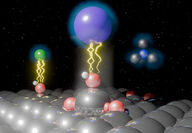Sorted by date Results 1 - 8 of 8

Japanese researchers unveil platinum electrode enhancement for producing clean hydrogen. Imagine a world where clean energy is not just a dream but a reality. Researchers at Chiba University have taken one step closer by cracking the code on platinum electrodes that are vital to hydrogen fuel cells and electrolysis. With subtle changes to the way these electrodes interact with water, they've discovered a game-changing method to boost both efficiency and durability – a small t...

Critical minerals company receives preliminary term sheet for mine financing from EXIM. The Export-Import Bank of the United States (EXIM) has extended an offer to loan NioCorp Developments Ltd. $800 million to help fund the development of Elk Creek, a critical minerals project in Nebraska that would provide a domestic source of niobium, titanium, scandium, and rare earths. "Our goal is to make North America less dependent on foreign suppliers for the critical minerals we...

Uses quantum mechanics to discover how light makes thin gold films glow. In a groundbreaking study, researchers at the Swiss Federal Institute of Technology in Lausanne (EPFL) have revealed the quantum secrets behind how light makes thin gold films glow. This discovery, solving a decades-old puzzle, could transform how we make solar fuels and batteries. Luminescence, the process where substances emit photons when exposed to light, has long been observed in semiconductor...

Talon and Argonne National Lab are working to transform iron waste products from nickel mines into a superior LFP battery cathode material. A mix of battery types is needed for a rapid and sustainable transition to electric vehicles. While lithium-ion batteries with nickel-cobalt-manganese (NCM) cathodes will continue to be the main choice for longer-range EVs in North America, lithium-iron-phosphate (LFP) offers an alternative for lower-cost cars used primarily for...

Thermal energy storage cavern twice the size of Madison Square Garden could heat Finland's fourth-most-populous city of Vantaa all year. Engineering advancements have recently made strides in sustainability by imitating nature as opposed to conquering it. In the case of storage, the global energy transition demands more powerful and efficient batteries as well as earth-friendly processes to get the technology where it needs to be, and one city in Finland is building the...

New nanofiber electrode material increases energy storage. The next generation of wearable and flexible devices will necessitate the development of more robust, lightweight energy storage systems and researchers at the Korea Institute of Science and Technology (KIST) have answered the call – developing modified carbon nanotube fibers in an electrode-like material that can offer 3.3 times the strength and 1.3 times the conductivity over regular carbon nanotubes. Technology c...

Idaho Copper is utilizing Veracio's digital ore scanning tech to accurately relog drill core in preparation for updated mine study. As the next step in its goal of providing a domestic source of copper to meet the United States' growing demand for this energy transition metal, Idaho Copper Corp. is leveraging Veracio's TruScan technology to digitally analyze more than 60,000 feet (18,290 meters) of core in preparation for ore sorting studies at its CuMo cop...

New capacitors are layered with 2D and 3D materials whose architecture promises higher energy and unprecedented efficiency. A group of researchers from the McKelvey School of Engineering at Washington University in St. Louis, Missouri, have developed a new metamaterial designed to advance the capabilities of ferroelectric capacitors, a discovery that could open the door for the widespread adoption of this elusive electrical storage solution across many technologies....